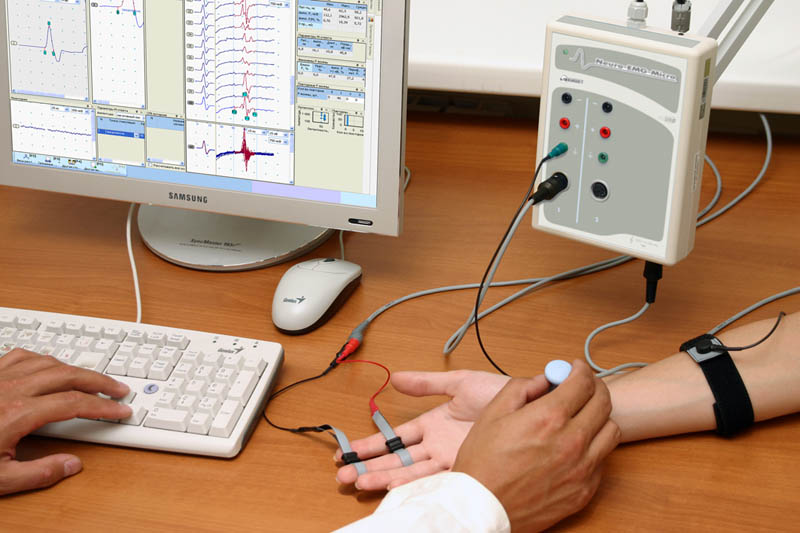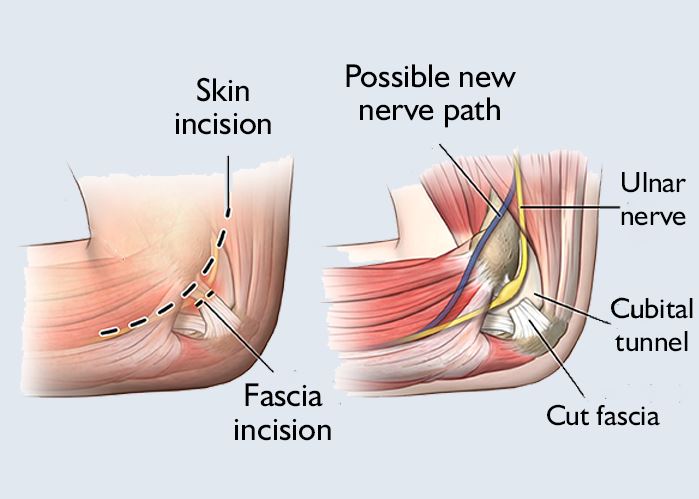Cubital tunnel syndrome surgery, cubital tunnel release surgery
Elbow tunnel release surgery is an intervention for the treatment of elbow (cubital) tunnel syndrome, in which the thickened ligament system is intersected, thereby releasing the nerve from the pressure of the swollen tendons.
What is tunnel syndrome?
Diseases in which the nerves in the “fissure” formed by the change in the body’s muscles, ligaments and bones of the are called tunnel syndrome. In such cases, the tendons swell for some reason, squeezing the nerves running beneath them, causing numbness or pain in those limbs.
It most commonly develops at the wrist, but can also appear in the elbow, around the brachial plexus that provides nerve innervation, in a groin, under the knee, and on the back of the foot.
How does cubital tunnel syndrome develop?
In tunnel syndrome, for some reason, a narrowing develops next to the descending nerve, which puts pressure on it. Elbow (cubital) tunnel syndrome is when the ulnar nerve that travels through narrow, bony ducts in the elbow is under pressure. The nerve can be affected more than the elbow, where it turns from the upper arm to the forearm, and when the elbow is bent and stretched, it is also more exposed to elongation.
Swelling of the soft areas around the nerve can be caused by several reasons. Most often, injury to the elbow, or bone growth is responsible for the development of the syndrome, but frequent elbowing, prolonged bending of the elbow, writing, or excessive mobile phone use can suppress peripheral nerves.
Systemic diseases such as thyroid dysfunction, rheumatoid arthritis, or diabetes may also be associated with cubital tunnel syndrome.
It most commonly develops in young adults as well as middle-aged people, in equal proportions in men and women. Its occurrence is more common in strenuous physical workers and athletes.

What are the symptoms of cubital tunnel syndrome?
The symptoms of cubital tunnel syndrome can be divided into two main groups. Since the ulnar nerve is a mixed nerve, in contains sensory and motor fibres, one group of symptoms consists of sensory complaints such as numbness, loss of sensation, pain in the ring and little finger, or an electric sensation due to a slight blow to the elbow. The other group of symptoms is the dysfunction of some muscles in the hand: atrophy of the inner small muscles of the hand, the patient feels clumsy, unable to bend their little finger well or close tightly to his ring finger.
The elbow is usually swollen, sensitive to pressure, especially along the ulnar nerve, and its range of motion is narrowed.
Symptoms initially appear at night, but as the disease progresses, they also appear during the day during certain activities.
How is cubital tunnel syndrome diagnosed?
The diagnosis of tunnel syndrome is usually made by an orthopaedic specialist. Knowing the complaints and medical history, if cubital tunnel syndrome is suspected, the specialist will perform a specific physical examination to support the diagnosis.
Since the cubital tunnel syndrome also has similar symptoms as other lesions (e.g. disc herniation, diseases of the circulatory system), in addition to the physical examination, a special examination, the so-called ENG (electroneurographic) examination is necessary as well. This test measures how fast the peripheral nerves carry the stimulus. The ability of the compressed nerve to conduct stimuli is significantly reduced.

An X-ray examination is also provided to establish the diagnosis, with possible bone structure abnormalities, fractures, and in some cases neural ultrasound examination (neurosonography) may be necessary.
How to treat cubital tunnel syndrome?
Cubital tunnel syndrome is first treated in a conservative (non-surgical) manner. Relieving the hand and elbow, night railing of the elbow in a semi-bent position can reduce swelling within the “canal”, leaving more space for the nerve. In more severe cases, taking non-steroidal anti-inflammatory drugs in addition, or drugs delivered to the cubital canal may reduce intra-canal swelling.
In addition, surgical treatment of the syndrome by a hand surgeon is also available. Surgery ensures the quickest and most effective treatment.
When is surgery warranted?
If conservative treatment does not lead to results, or a decrease in nerve conduction velocity is greater than moderate, a surgical solution is recommended.
What happens during the surgery?
During the preoperative consultation, your orthopaedist will provide detailed information about the necessary preoperative tests, as well as the course of the surgery and its risks.
The cubital tunnel release surgery is performed as part of a one-day surgical procedure.
The surgery is performed under general or local anaesthesia. During cubital tunnel release surgery, the hand surgeon relieves the pressure on the nerve by cutting through the callus ligament that forms the top of the tunnel.
During the procedure, the inflammatory tissue proliferation surrounding the tendons is also removed, and the resulting wound is sutured with a few stitches.


What are the risks of surgery?
As with any medical intervention, cubital tunnel release can have risks and complications. Very rarely, inflammation and infection of the surgical site, as well as damage to the surrounding anatomical formulas may occur: injuries to tendons, muscles, blood vessels, or the ulnar nerve itself. In such cases, medication may be required in milder cases and repeated surgery in more severe cases.
What can I expect after the surgery?
The sterile, surgical dressings should be replaced the next day. If the joint is not damaged, no further dressing is required until the sutures are removed. Suture collection takes place 10 days after surgery. Gentle exercises of the elbows, hands, wrists and fingers are recommended from day 2.
After surgery, scar sensitivity around the skin incision may persist for a few weeks, possibly months.
Numbness and pain may go away at different rates in the individual few days after surgery. However, the return of the handgrip strength, the complete disappearance of the numbness, and the restoration of the original activity of the hand can take months, which can be made faster with personalized physiotherapy.
What is included in the price of our surgeries?
- costs of the surgery
- costs of anesthesia (local or general anesthesia, postoperative pain relief)
- the costs of the planned hospital stay and care
- necessary medicines and certain medical aids during the stay
- inpatient physiotherapy treatment (if necessary for rehabilitation)
- if necessary, the fee for the planned histological examination
- the price of the first follow-up examination
What additional costs might be expected?
- implants
- consultation with the anesthesiologist (must be done in Medicover)
- pre-operative examinations (if performed by us)
- in case of blood group antibody positivity, the blood matching fee
- hotel service fee for extra care days
- aids for further rehabilitation
- accompanying person staying in the hospital
- day (with one meal) 20 000 HUF
- night (full board) 60 000 HUF
- furthermore, if necessary, the cost of the 2nd follow-up examination is the fee of the specialist examination -50%, the cost of the 3rd follow-up examination is the fee of the specialist examination -30%
The course of the surgery
Before surgery
- pre-surgery specialist consultation, where the specific surgical proposal is made
- consultation with the Case Manager
- general information if necessary
- preparation of a written quotation
- booking surgery and preliminary examination appointments
- payment
-
carrying out pre-operative examinations
-
arrival for surgery
On the day of surgery
- arrival at Medicover Hospital at 6:30
- check-in at the reception on the ground floor
- occupying a room accompanied by a nurse, who provides information
- morning visit with the specialist physician and anesthesiologist
- surgery
- postoperative monitoring
- afternoon visit with the specialist physician
- constant anesthesiology specialist monitoring in the postoperative period
- discharge (with an accompanying person), final report and handing over a certificate
Surgical service process
- surgery
- hospital stay and care
- planned histology
- follow-up examination, sutur removal
